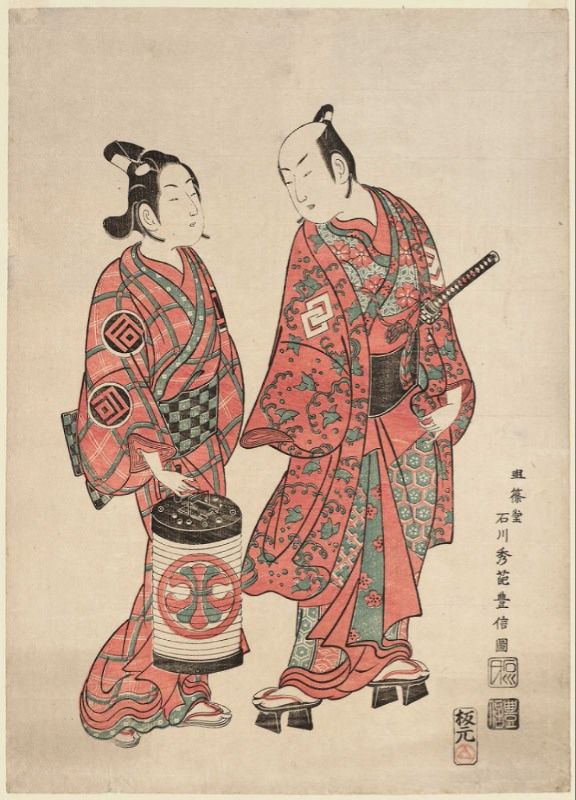Wow. This week certainly took me places I did not expect. When I chose kabuki as this month’s deep dive, I thought it would be a fairly straightforward topic. Just learn as much as I can about kabuki. I had no idea this deep dive would lead me down so many rabbit holes. But this is what I love about the Daily Hart. I always learn so much more than I ever expected. Case in point. This week started out harmlessly enough. I simply googled ‘wakashu kabuki’. Easy, right? I guess that would depend on your definition of easy, because this week ended with me reading dissertations on the history of homosexuality in premodern Japan. It was a wild ride.
As you may recall, last week’s post was all about onnogata kabuki, meaning the men who perform women’s roles in kabuki. Onnogata exist because women were banned from performing kabuki in 1629. However, they were not immediately replaced by men. Instead, young boys initially filled the roles of kabuki performers. These boys were called wakashu, and they were typically aged between 11 and 15. The wakashu brought a lot of new physical elements to kabuki, including juggling, acrobatics, and tightrope walking. They also had very short careers. Once they turned 15, they shaved their foreheads as part of the gempuku coming of age ceremony, and their time onstage would be over. Although the wakashu incorporated a lot of new elements into kabuki performances, they kept what had made kabuki so popular in the first place. Wakashu were known for their erotically charged dances, and many of the performers also worked as prostitutes backstage.
Needless to say, I was curious about how this practice was perceived by the public at the time. Japan today is not exactly known for being a bastion of gay rights, so I wanted to know more about historical feelings on the matter. And this is where I fell head first into a rabbit hole I never saw coming. Turns out, homosexuality in premodern Japan was not only widely practiced, but relations between older men and teenaged boys was the norm. In fact, it was actively encouraged. I read many an article this week that compared premodern Japan to ancient Greece when it came to views on homosexuality. Say what??? I had to know more.
Thankfully, there was a surprising amount of information available. Also surprisingly, a lot of this history centres around religion. Yes. Religion. That social construct that is famously very much against same-sex relations. At least, the religions I’m familiar with are. But I’m not very familiar with Shintoism or Japanese Buddhism. And according to what I read this past week, both of these religions are very sex positive. Or they used to be. I must admit that I did not read much about current religious attitudes in Japan, so it is entirely possible that things have since changed. But hundreds of years ago, sexual love was seen as an unconditional good. No matter who it was between. How refreshing.
I also discovered that records of same-sex relations in Japan go back thousands of years. However, it was particularly prevalent in the all-male Buddhist monasteries, where an older man would be paired with an adolescent boy in a structured relationship of apprenticeship. This practice was called nanshoku, and it was brought over from China in the 8th century. The samurai eventually took over from the clergy as the ruling class in the 12th century, and they continued this tradition for centuries. Over time, nanshoku filtered down to the middle classes as commoners tried to emulate the upper classes. In all cases, these relationships were seen as mutually beneficial and completely normal. So much so that nanshoku was well documented in public records and the arts of the time.
So what does this have to do with kabuki? Well, the golden age of nanshoku happens to coincide with the time of the wakashu. It was a time when male prostitutes were in high demand, and performing onstage was a great way to advertise your wares. Many wakashu enjoyed a thriving trade and were treated as celebrities. So much so that many of them delayed shaving their heads to retain their youthful looks and remain onstage long after they had officially come of age. The wakashu were particularly favoured by Shogun Iemitsu, who would often invite them back to the palace for after hours entertainment. Unfortunately, when Iemitsu died in 1651, his favour died with him. The wakashu were banned the following year.
Homosexuality itself was not, however. It wasn’t until Japan opened its doors to foreign trade in the 19th century that attitudes began to change. And change they did. In an effort to appeal to western sensibilities, homosexuality was suddenly condemned and even briefly criminalized. In other words, just another example of western colonialism ruining everything. But for centuries, same-sex relations in Japan were the rule, not the exception, and it had a huge influence on Japanese arts for centuries.
So there you have it. Another fascinating rabbit hole of history courtesy of the Daily Hart. And all because I wanted to know more about wakashu kabuki. I can’t wait to see what rabbit hole is in store for me next week.
Happy Sunday all!
Suggestions for artists I should check out? Please contact me with your ideas. I hope you enjoyed your daily helping of art!



